Discover 20 hidden attractions, cool sights, and unusual things to do in Málaga (Spain). Don't miss out on these must-see attractions: Alcazaba, Jardín Botánico La Concepción, and Málaga Cathedral. Also, be sure to include Plaza de toros de La Malagueta in your itinerary.
Below, you can find the list of the most amazing places you should visit in Málaga (Andalusia).
Table of Contents
Alcazaba
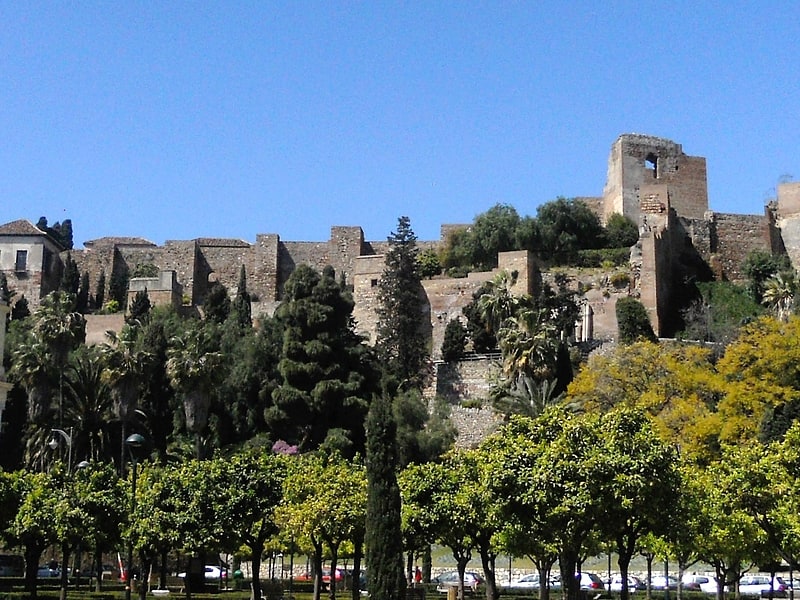
Medieval Moorish palace with sea views. The Alcazaba is a palatial fortification in Málaga, Spain. It was built by the Hammudid dynasty in the early 11th century.
It is the best-preserved alcazaba (from the Arabic al-qasbah, قصبة, meaning "citadel") in Spain. Adjacent to the entrance of the Alcazaba are remnants of a Roman theatre dating to the 1st century BC, which are undergoing restoration. Some of the Roman-era materials were reused in the Moorish construction of the Alcazaba. The Alcazaba was connected by a walled corridor to the higher Castle of Gibralfaro.
Ferdinand and Isabella captured Málaga from the Moors after the Siege of Málaga (1487), one of the longest sieges in the Reconquista, and raised their standard at the "Torre del Homenaje" in the inner citadel.
According to architect restorer, Leopoldo Torres Balbás, the Alcazaba of Málaga is the prototype of military architecture in the Taifa period, with its double walls and massive entry fortifications. Its only parallel is the castle of Krak des Chevaliers in Syria.[1]
Address: Calle Guillen Sotelo, 29016 Málaga (Málaga-Centro)
Jardín Botánico La Concepción
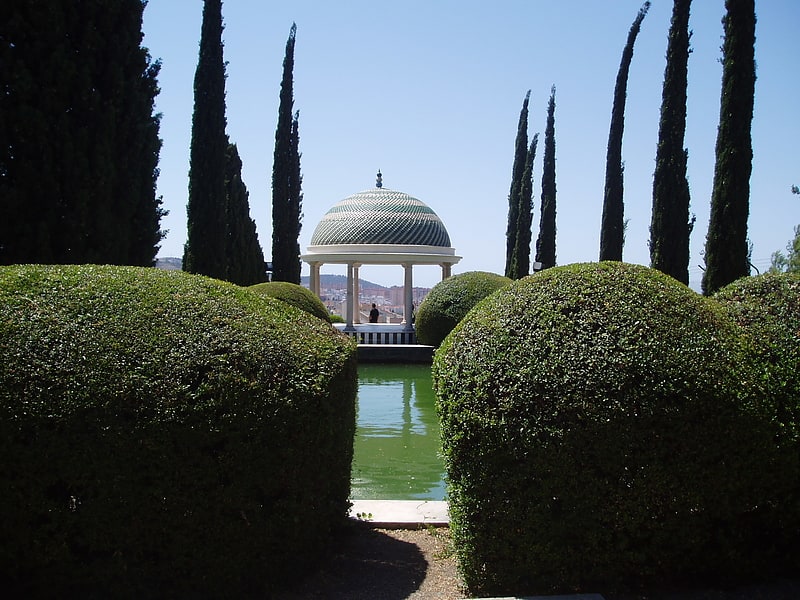
The Jardín Botánico Histórico La Concepción is an English landscape garden with over one hundred and fifty years of history. It is located at the northern entrance of the Spanish city of Málaga. This garden is one of the few gardens with subtropical plants that exist in Europe. It has more than fifty thousand plants, of two thousand species of tropical, subtropical, and autochthonous, highlighting the collection with more than one hundred different species of palms, bamboos, aquatic plants and its historical garden.
It originally was a recreational estate of a family of the upper bourgeoisie of the city from the mid-19th century until 1990 when it became public property. The Málaga City Council founded for its management the Municipal Botanical Board 'Ciudad de Málaga'.[2]
Address: Camino del Jardin Botanico 3, 29014 Malaga (Ciudad Jardín)
Málaga Cathedral

Also known as: Catedral de Málaga
Landmark cathedral and a museum. The Cathedral of Málaga is a Roman Catholic church in the city of Málaga in Andalusia in southern Spain. It is in the Renaissance architectural tradition. The cathedral is located within the limits defined by a now missing portion of the medieval Moorish walls, the remains of which surround the nearby Alcazaba and the Castle of Gibralfaro. It was constructed between 1528 and 1782, following the plans drawn by Diego de Siloe; its interior is also in Renaissance style.[3]
Address: Calle Molina Lario, 9, 29015 Málaga (Málaga-Centro)
Plaza de toros de La Malagueta
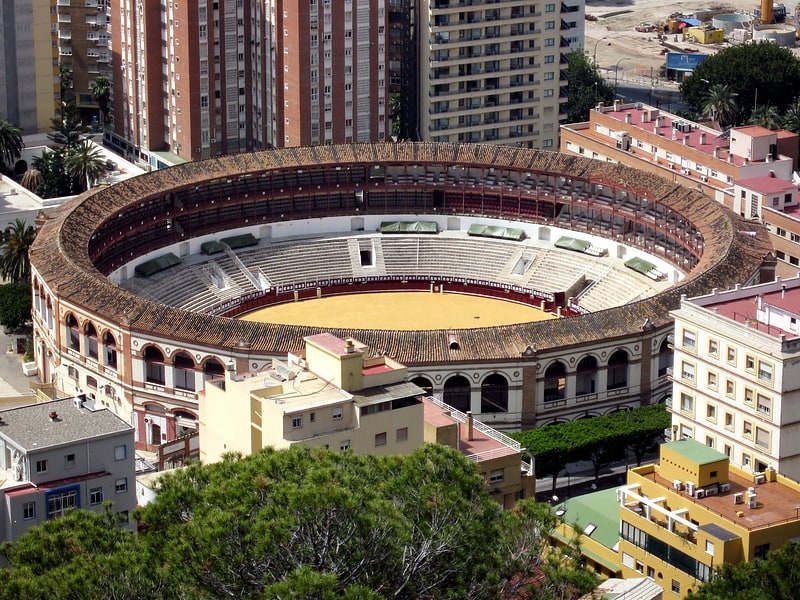
Bullring with a museum of memorabilia. La Malagueta is a bullring at Málaga, Andalucía, Spain which since 1876 has been denominated a cultural asset of Spain. It is located in the eastern district of Málaga, alongside the Paseo de Reding.
The first event was held in 1876. the current (2013 season) operator is Coso de Badajoz SL, a company owned by José Cutiño.[4]
Address: Málaga, PSO REDING 8
Museo Picasso Málaga
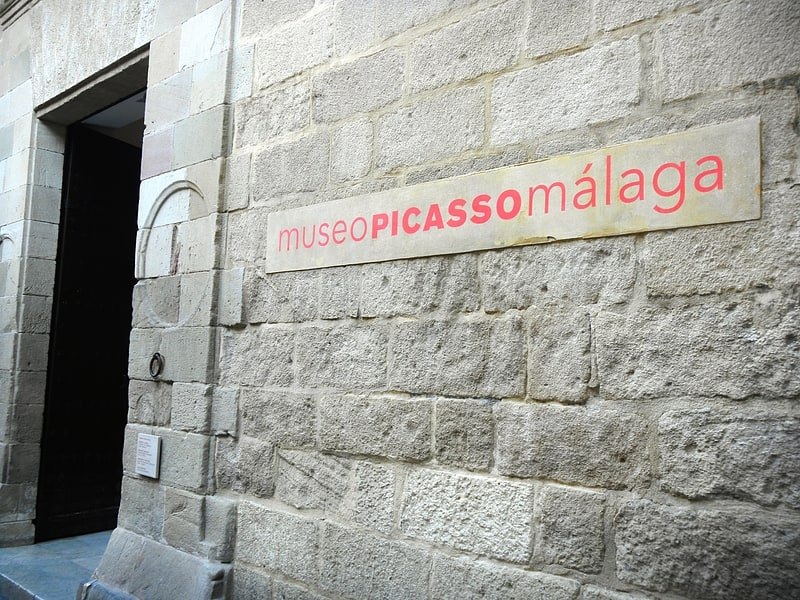
Picasso collection in a converted palace. The Museo Picasso Málaga is a museum in Málaga, Andalusia, Spain, the city where artist Pablo Ruiz Picasso was born. It opened in 2003 in the Buenavista Palace, and has 285 works donated by members of Picasso's family. In 2009, the Fundación Paul, Christine y Bernard Ruiz-Picasso that owned the collection merged with the Fundación Museo Picasso Málaga that operated the museum, which is based in the home on Málaga's Plaza de la Merced that was Picasso's birthplace, and is now the Museo Casa Natal. The new merged foundation is the "Fundación Museo Picasso Málaga. Legado Paul, Christine y Bernard Ruiz-Picasso".[5]
Address: Calle San Agustin 8, 29015 Malaga (Málaga-Centro)
Palacio de la Aduana

Fine art museum in 1791 palace. The Palacio de la Aduana is a building in Málaga, Andalusia, Spain, originally a customs house for the Port of Málaga.
The building was proposed by Manuel Martín Rodríguez in 1787 and approved by Charles III of Spain. Work began in 1791 under the direction of administrador general of Customs Pedro Ortega Monroy and architects Miguel del Castillo and Ildefonso Valcárcel, who designed the principal façade and floor plans. Work was still under way in 1810 when the building was sacked during the occupation of Málaga by French forces during the Peninsular War; after the war, damage was repaired and construction continued. Architect Pedro Nolasco Ventura made various modifications to the plans, and the building was completed in 1829.
The Neoclassical building was modeled on Renaissance Italian palaces. Four corridors or bays surround a central patio that is porticoed for the lower two floors; then set back on the third floor, where there is an open gallery with an openwork balustrade functioning as a parapet; between sections of the parapet are Roman busts atop low walls. The building has bossed exterior walls; towering palm trees that flank the main façade.
Originally a customs house, it later served in the later 19th century as the Real Fábrica de Tabaco (Royal Tobacco Factory), as the seat of the city government, and as the Subdelegation of the Spanish Government in the Province of Málaga beginning in the Franco era, and was later used also by the Policía Nacional. As of 2004, it was being used by the Subdelegation, and the Policía Nacional, and to store the collection of the Fine Arts section of the Museo de Málaga, which lost its previous site in the Buenavista Palace when that was taken over by the Museo Picasso Málaga.
The original roof was destroyed by a fire in the tobacco factory era. On 25–26 April 1922, while functioning as the seat of the government, the building experienced a terrible fire. The wooden staircases to the top floor caught fire; at the time, there were 70 government functionaries living on that floor. 28 people died, and years of archives were destroyed.
The building is currently (as of February, 2012) being rehabilitated for permanent museum use by the Museo de Málaga. The Ministry of Culture has hired the construction firm Sacyr to rehabilitate the building, following the designs of architects Fernando Pardo, Bernardo García Tapia, and Ángel Pérez Mora. The project is budgeted at 23.6 million euros. The museum is projected to open in 2013.[6]
Address: Plaza de la Aduana, 29015 Málaga (Málaga-Centro)
Museo de Málaga
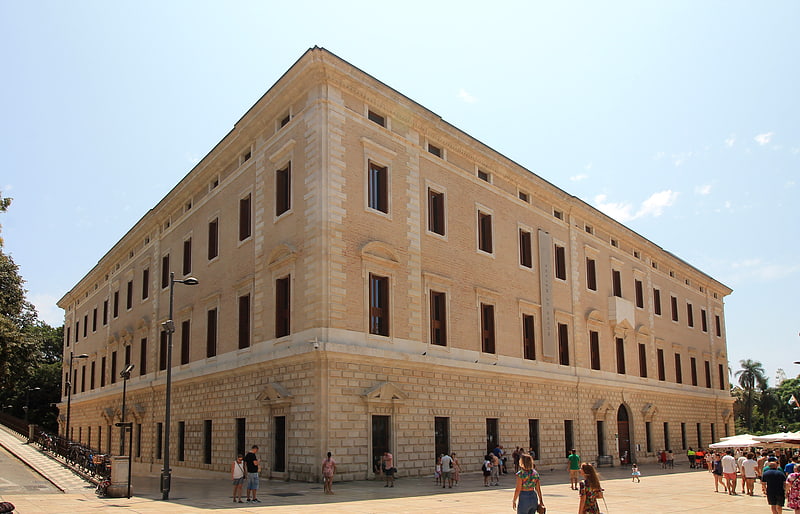
Museum in Málaga, Spain. The Museo de Málaga is a museum in Málaga, Andalusia, Spain. Formed in 1973, it brought together the former Museo Provincial de Bellas Artes, born in 1913, and Museo Arqueológico Provincial, born in 1947. As of 2010, the museum remains institutionally divided into two "sections" corresponding to the older museums. There are slightly over 2,000 pieces in the Fine Arts collection and over 15,000 in the Archeology collection. The museum opened to the public in December 2016, becoming the biggest museum in Andalusia and the 5th in Spain.[7]
Address: Plaza Aduana s/n, 29015 Malaga (Málaga-Centro)
Museum Jorge Rando
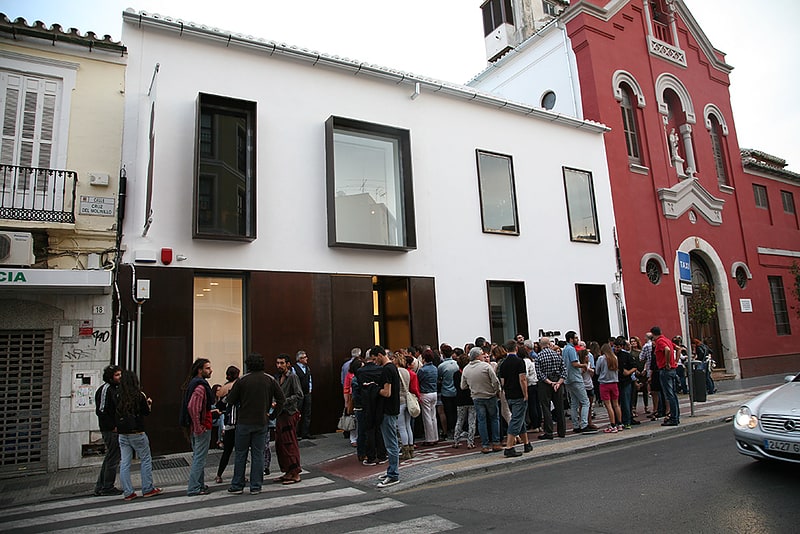
Museum in Málaga, Spain. The Museum Jorge Rando is the first expressionist museum in Málaga, Andalusia, Spain. Dedicated to the painter Jorge Rando, it collects his works and it temporally hosts the works of other national and international artists belonging to this movement. It was officially inaugurated on May 28, 2015.[8]
Address: Calle Cruz del Molinillo, 12, 29013 Málaga (Málaga-Centro)
Estadio La Rosaleda
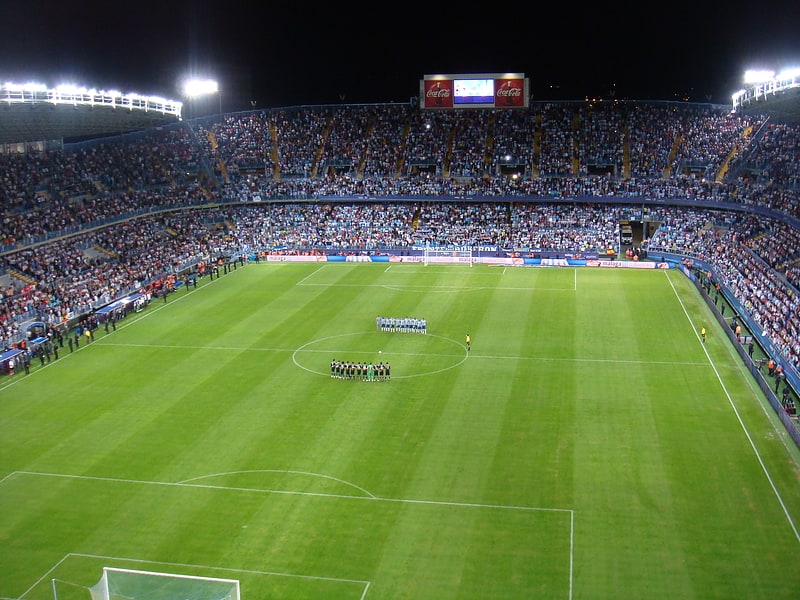
Stadium in Málaga, Spain. Estadio La Rosaleda is a football stadium in the city of Málaga, in Andalucia, southern Spain. It is the home stadium of Málaga CF in Segunda División and was previously that of the Club Deportivo Málaga, of which Málaga CF is heir. The subsidiary Atlético Malagueño also used it as a habitual pitch during his time in the second division. The Costa del Sol Trophy Cup, organized annually by the Málaga Football Club together with the Municipality of Málaga, is held in this stadium. With a capacity of 30,044 seats, it is the 18th-largest stadium in Spain and the 4th-largest in Andalusia.
This replaced the football field Málaga historic arena of Baños del Carmen. When it flooded, the rose garden had to be used for the first time on 13 April 1941 with a fixture between the CD Málaga and AD Ferroviaria. However, the official inauguration took place on 14 September 1941, with a friendly match between the CD Málaga and Sevilla. In this match, CD Málaga also premiered name since its previous name was CD Malacitano.[9]
Address: Paseo Martiricos s/n, 29009 Malaga (Palma-Palmilla)
Fundación Picasso

Museum in Málaga, Spain. The Fundación Picasso, also known as the Pablo Ruiz Picasso Foundation, is a foundation based in Málaga, Andalusia, Spain with the objective of promoting and promulgating the work of the artist Pablo Picasso. They are headquartered in the home on the Plaza de la Merced that was his birthplace, now the Museo Casa Natal, one of the world's many Picasso museums.
The Fundación Picasso is distinct from the former Fundación Paul, Christine y Bernard Ruiz-Picasso ("Paul, Christine and Bernard Ruiz-Picasso Foundation") and Fundación Museo Picasso Málaga ("Malaga Picasso Museum Foundation"), both associated with the much larger Museo Picasso Málaga. Those two foundations merged in December 2009 to form the "Fundación Museo Picasso Málaga. Legado Paul, Christine y Bernard Ruiz-Picasso" ("Museo Picasso Málaga Foundation. The Paul, Christine and Bernard Ruiz Picasso Legacy").
The foundation was created by the city government of Málaga in 1988. Headquartered since its founding in the Casa Natal—declared a Historical-Artistic Monument of National Interest—it later obtained an additional exhibition space at Number 13 of the same plaza in 2005.
The facility includes a Picasso documentation center; art collections; a department of cultural promotion, which organizes expositions and conferences; and the Museo Casa Natal. In 2009 the Andalusian Autonomous Government agreed to give the foundation the Palacio de Buenavista (seat of the Museo Picasso Málaga), as a result of the merger of the Fundación Picasso and the Fundación Paul, Christine y Bernard Ruiz-Picasso. The new merged foundation is officially the "Fundación Museo Picasso Málaga. Legado Paul, Christine y Bernard Ruiz-Picasso" ("Museo Picasso Málaga Foundation. The Paul, Christine and Bernard Ruiz Picasso Legacy").
Besides their collection of works by Picasso, the museum also has a collection of the work of the philosopher, inventor, and kinetic sculptor Frank Rebaxes and a collection of sketches by Luis Molledo. There is also a large collection of works by other artists, with a particular emphasis on engravings. There are engravings by Pablo Palazuelo, Manuel Hernández Mompó, Eduardo Arroyo, Rafael Canogar, Manuel Rivera, Arman, Alfonso Albacete, Manuel Quejido and Marc Chagall, and other graphic works by Joan Miró, Christo, Francis Bacon, Joan Brossa, Max Ernst, Antoni Tàpies, Eduardo Chillida, Perejaume, Jaume Plensa, Dokoupil, Oswaldo Guayasamín, Josep Guinovart, Wifredo Lam, Roberto Matta, Henry Moore and others. There are also works by local Malagan artists Manuel Barbadillo, Enrique Brinkmann, Eugenio Chicano, Jorge Lindell, Francisco Peinado, and Dámaso Ruano; works by Carlos Durán, Joaquín de Molina, Diego Santos, and Joaquín Gallego; works by the winners of the Beca Pablo Ruiz Picasso a las Artes Plásticas (Pablo Ruiz Picasso Scholarship for the Plastic Arts); and a small collection of sculpture.[10]
Address: Plaza Merced 15, 29012 Malaga (Málaga-Centro)
Museo Carmen Thyssen
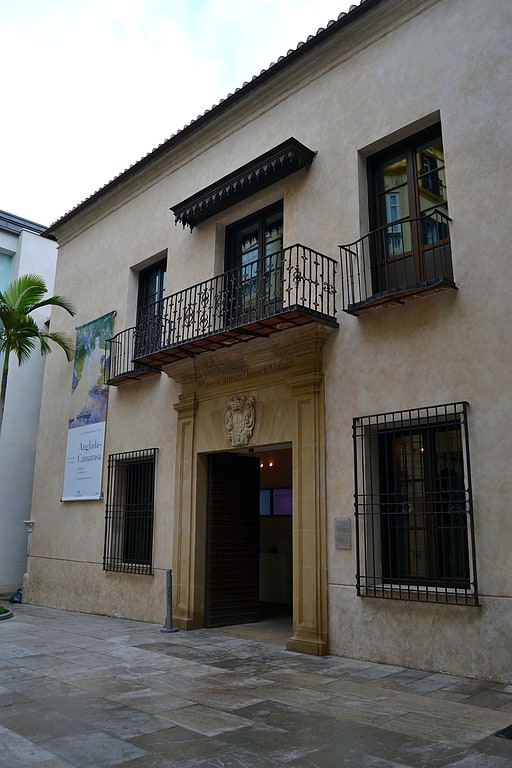
Grand art museum in a Renaissance palace. The Carmen Thyssen Museum is an art museum in the Spanish city Málaga. The main focus of the museum is 19th-century Spanish painting, predominantly Andalusian, based on the collection of Carmen Cervera, fifth wife of Baron Hans Heinrich Thyssen-Bornemisza.
Since 1992 the Thyssen family's art collection has been on display at the Thyssen-Bornemisza Museum in Madrid. However, Carmen Thyssen has been an art collector in her own right since the 1980s, and her personal collection is shown separately. In 1999, she agreed to display many items from her collection in the Thyssen-Bornemisza Museum for a period of twelve years. Meanwhile, a home for her collection was sought in Málaga. This museum, a conversion of a sixteenth-century building, opened to the public on 24 March 2011.[11]
Address: Calle Compañía, 10, 29008 Málaga (Málaga-Centro)
Reding Fountain
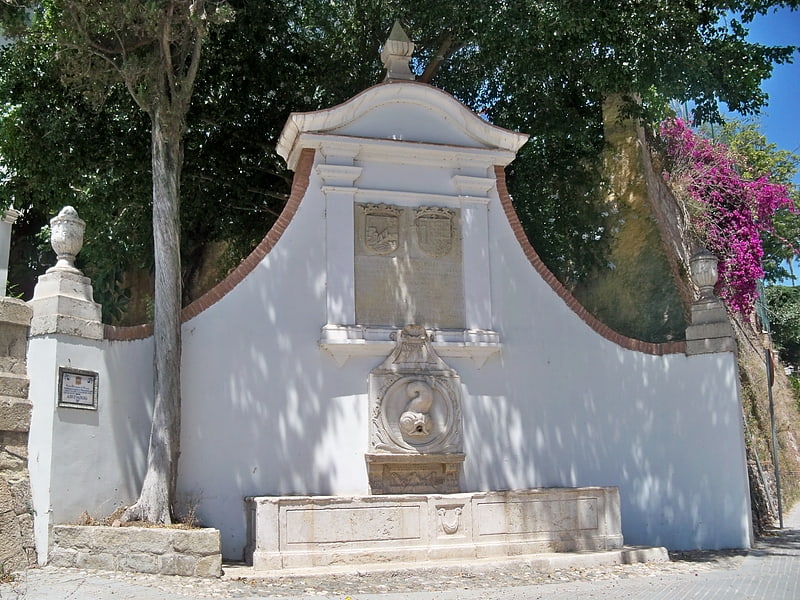
The Reding Fountain is a historic 17th-century fountain located in the Andalusian city of Málaga, Spain.
It has been reproduced countless times by local painters. It is located at one end of the Príes Avenue and pipes spring water from the Mount Gibralfaro.[12]
English Cemetery
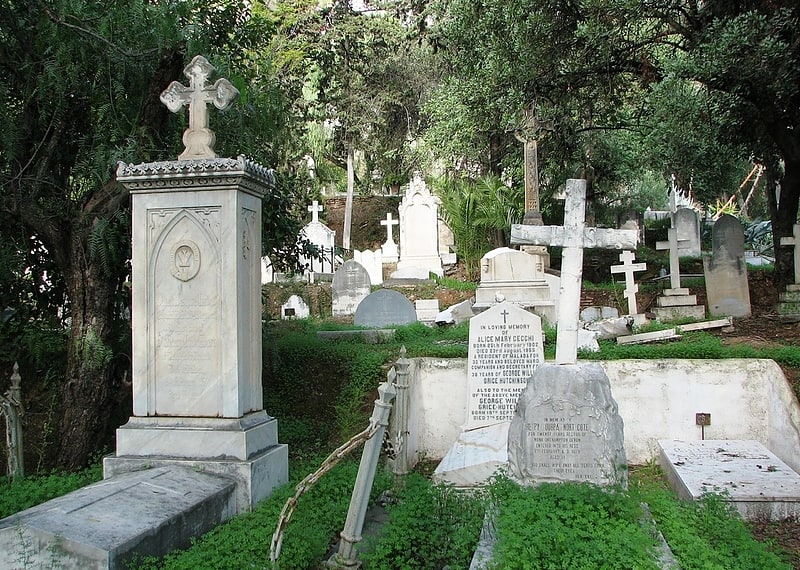
Also known as: Cementerio Inglés
Cemetery in Málaga, Spain. The English Cemetery in Málaga, or Anglican Cemetery, or Cemetery of St George, is the oldest non-Roman Catholic Christian cemetery established on mainland Spain.[13]
Address: Avenida Pries 1, 29016 Malaga (Málaga-Centro)
Alcazaba
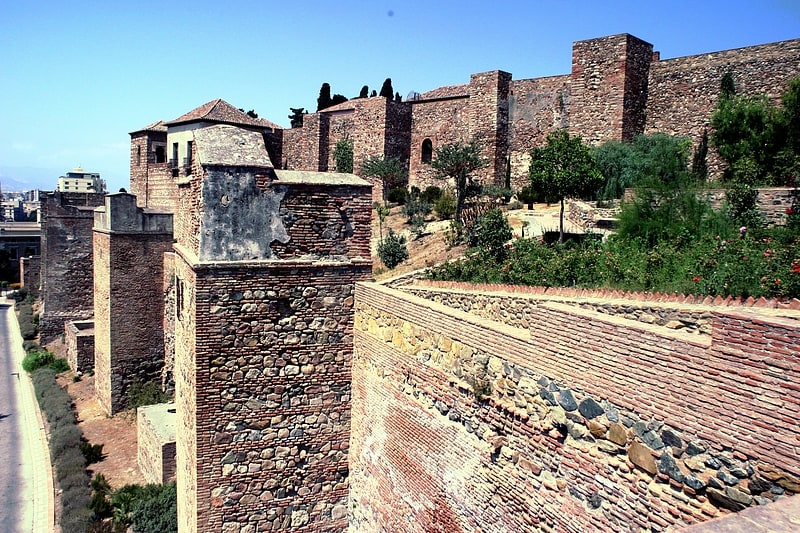
A kasbah, also spelled qasba, qasaba, or casbah, is a fortress, most commonly the citadel or fortified quarter of a city. It is also equivalent to the term alcazaba in Spanish, which derives from the same Arabic word. By extension, the term can also refer to a medina quarter, particularly in Algeria. In various languages, the Arabic word, or local words borrowed from the Arabic word, can also refer to a settlement, a fort, a watchtower, or a blockhouse.[14]
Address: Calle Alcazabilla, 2, Málaga (Málaga-Centro)
Palacio de Buenavista
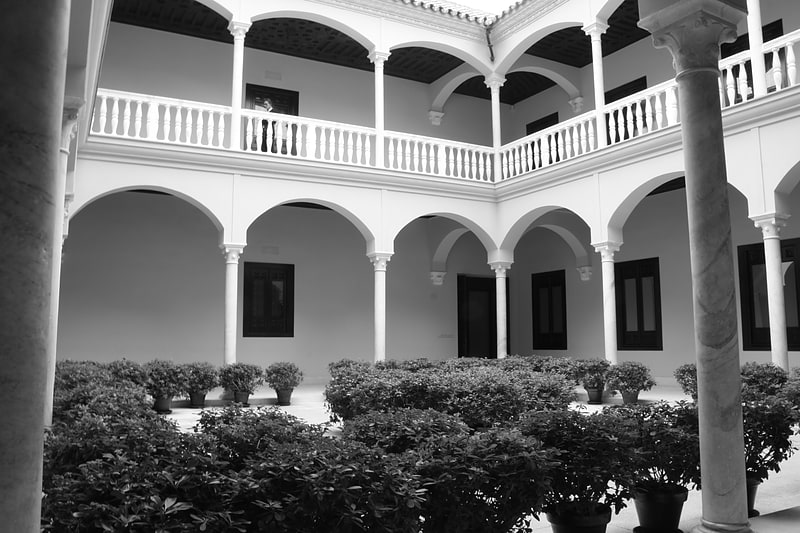
Also known as: Palacio de los Condes de Buenavista
Buenavista Palace is a historical edifice in Málaga, Andalusia, Spain. It was built in the first half of the 16th century for Diego de Cazalla on the ruins of a Nasrid palace. Declared a "Property of Cultural Interest" in 1939, it was leased to the Spanish government in 1946 for a provincial art museum, which opened in 1961. In 1997 it was acquired to house the present Museo Picasso Málaga, which opened there in 2003. It is located in the historic center of Málaga, in the Calle San Agustín in the former Jewish quarter, next to the San Agustín convent and not far from the Cathedral of Málaga.[15]
Port of Málaga
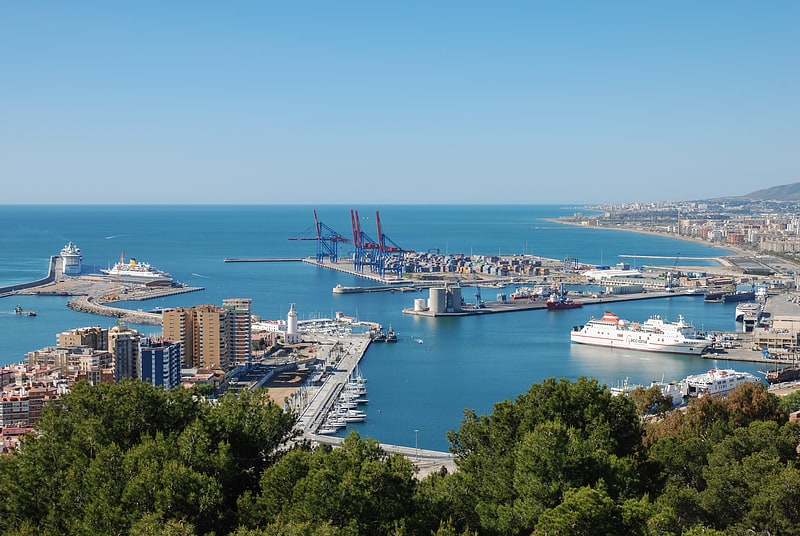
Also known as: Puerto de Málaga
The Port of Málaga is an international seaport located in the city of Málaga in southern Spain, on the Costa del Sol coast of the Mediterranean. It is the oldest continuously-operated port in Spain and one of the oldest in the Mediterranean.
Principal port activities include cruise shipping and the importation of containerised manufactured products, break bulk and vehicles. A small fishing fleet also operates from the port.[16]
Castillo de Gibralfaro
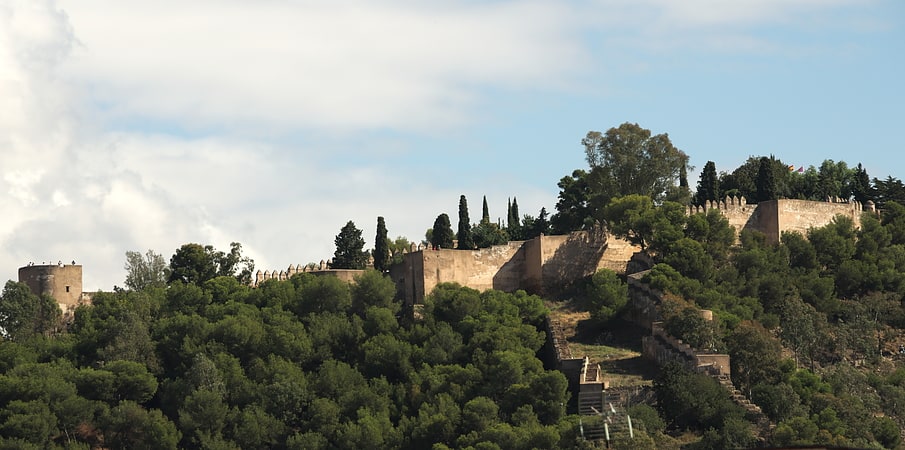
Gibralfaro Castle Castle in Malaga, erected by Jusuf I, the Muslim ruler of Grenada in the first half of the fourteenth century.
The castle was erected upstairs with a height of 131 m a.s.l. For a defense located at the foot of the older fortress (Alcazaba), with which it is connected by a passage, protected by one line of walls.
The name of the mountain comes from Arab. Jabal - Góra and Greek. Pharos - lighthouse, pointing to the use of the mountain as a former navigation sign.
Before building the castle, there were Phoenician buildings.
After Malaga gained by the Spaniards in 1487, the castle was the residence of Ferdinand II Catholic and his wife Izabela and Catholic. The castle played a military role until 1925.
The castle was built taking into account new solutions at the time. The walls running with a zigzag allowed to give up building flanking towers, and the main gate, placed in the lowest part, was built in such a way that the attacker, after pushing one door, had to change the direction (which weakened the impetus of the attack and prevented, for example, the use of large ramns) and for example) and Get a second door, while the defenders could offend them from the top of the gate without the roof.
Currently, the defensive walls remained by design are available for sightseeing. At the top of the wall there is a ramp from which the city is viewed, and with good visibility you can see Gibraltar and the Atlas Mountains. Other buildings remained wells and tanks, as well as a much newer building of the gunpowder, in which an exhibition was arranged, presenting weapons, uniforms and equipment of troops from the 16th century to the beginning of the 20th century.
Address: Camino Gibralfaro s/n, 29016 Malaga (Málaga-Centro)
Costa del Sol

Municipality in Spain. The Costa del Sol is a region in the south of Spain in the autonomous community of Andalusia, comprising the coastal towns and communities along the coastline of the Province of Málaga and the eastern part of Campo de Gibraltar in Cádiz. Formerly made up only of a series of small fishing settlements, today the region is a world-renowned tourist destination. The Costa del Sol is situated between two lesser known coastal regions, the Costa de la Luz and the Costa Tropical.
The region has no official limit, but it is generally accepted that the Costa del Sol stretches from the municipality of La Línea de la Concepción in the west to Nerja in the east, spanning around 150 kilometers of coastline. The term Costa del Sol was coined at the beginning of the 20th century by Rodolfo Lussnigg to promote the Almería coastline. Until the late 1960s, it was used in reference to the entire Mediterranean coast of Eastern Andalusia. The name refers to the sunny climate, present in the region most days of the year. The Costa del Sol is one of the most important tourist areas in Spain; around 35% of Andalusia's tourism is concentrated in the region; in 2009 it had 17 million overnight stays.
The region was a relatively prosperous commercial and industrial center for much of the 19th century. The tourist boom in the area began in the 1920s with the opening of the Baños del Carmen in Málaga and a golf course in Torremolinos. It became an international tourist destination in the 1950s and is today particularly popular among British, German, Scandinavian and French tourists. The most populated city on the Costa del Sol is the city of Málaga, with a metropolitan population of close to one million. Málaga is home to the Málaga-Costa del Sol Airport, which is the third busiest airport in mainland Spain, behind Barajas (Madrid) and El Prat (Barcelona).
The A-7 highway runs through the region, as does the old national highway generally known as N-340. High-speed trains serve the coastal region and inland areas, the AVE service reaches the Málaga-María Zambrano railway station in 2 hours and 46 minutes from Madrid. The Costa del Sol has a population of 1,412,541 inhabitants. The Costa del Sol has spas in Málaga, Tolox, Estepona, Benahavís, Benalmádena, Mijas, Torremolinos and Marbella, the largest concentration of golf courses on the European continent, fifteen marinas, nine theme parks (including amusement parks, aquariums and zoos), as well as an information and communication technology business park (PTA), a Google cybersecurity center and a Vodafone research and development center.[17]
Al-Andalus Mosque
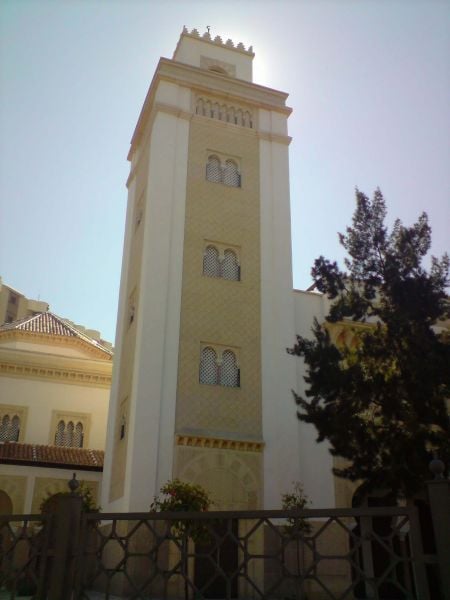
Also known as: Mezquita de al-Ándalus
Mosque in Málaga, Spain. Al-Andalus Mosque is a mosque in the neighbourhood of Arroyo del Cuarto city of Málaga, Andalusia, Spain.[18]
Address: Calle Ingeniero De La Torre Acosta, 3, 29007 Málaga (Cruz de Humilladero)
Gibralfaro

Hill in Spain. Mount Gibralfaro, Spanish: Monte Gibralfaro, is a hill located in Málaga in southeast Spain. It is a 130 m high foothill of the Montes de Málaga, part of the Cordillera Penibética.
At the top of the hill stands the Castle of Gibralfaro overlooking Málaga city and the Mediterranean Sea, and connected by a walled corridor to the Alcazaba of Málaga.[19]